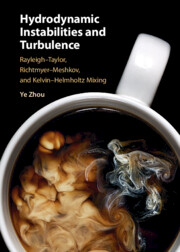 Hydrodynamic Instabilities and Turbulence
Hydrodynamic Instabilities and Turbulence Book contents
- Frontmatter
- Dedication
- Contents
- Preface
- Acknowledgments
- Part 1 Fundamentals
- Part 2 Hydrodynamics of Complex Flows
- Part 3 From the Microscopic to Cosmic Scales
- 18 High-energy-density physics
- 19 Inertial confinement fusion implosion
- 20 Laboratory applications
- 21 Astrophysical and space applications
- 22 Mixmodels
- 23 Numerical simulations of mixing
- 24 Does 2D turbulence resemble 3D turbulence?
- References
- Index
21 - Astrophysical and space applications
from Part 3 - From the Microscopic to Cosmic Scales
Published online by Cambridge University Press: aN Invalid Date NaN
- Frontmatter
- Dedication
- Contents
- Preface
- Acknowledgments
- Part 1 Fundamentals
- Part 2 Hydrodynamics of Complex Flows
- Part 3 From the Microscopic to Cosmic Scales
- 18 High-energy-density physics
- 19 Inertial confinement fusion implosion
- 20 Laboratory applications
- 21 Astrophysical and space applications
- 22 Mixmodels
- 23 Numerical simulations of mixing
- 24 Does 2D turbulence resemble 3D turbulence?
- References
- Index
Summary
This chapter will provide a detailed presentation of the basic structure of the supernova and its core collapse process to illustrate the roles that RMI, RTI, and KHI play in the different stages of these processes. During the explosions, the shockwave passing through the onion-like supernova core will generate both RMI and RTI. The RTI is the key physical process creating the filament structures observed in the Crab Nebula. MHD RT instabilities will be presented to show how they can further improve the comparison between simulations and observations. Several additional applications where hydrodynamic instability plays an important role will also be examined. Geophysics and solar physics also present effective lenses to view the importance of hydrodynamic instabilities. In the case of solar physics, I will describe how RTI’s impact can be viewed through various phenomena, such as the plumes that rise from low density bubbles as well as eruptions that occur as material returns to the solar surface. Once again, MHD RT instabilities are relevant.
- Type
- Chapter
- Information
- Hydrodynamic Instabilities and TurbulenceRayleigh–Taylor, Richtmyer–Meshkov, and Kelvin–Helmholtz Mixing, pp. 442 - 456Publisher: Cambridge University PressPrint publication year: 2024


